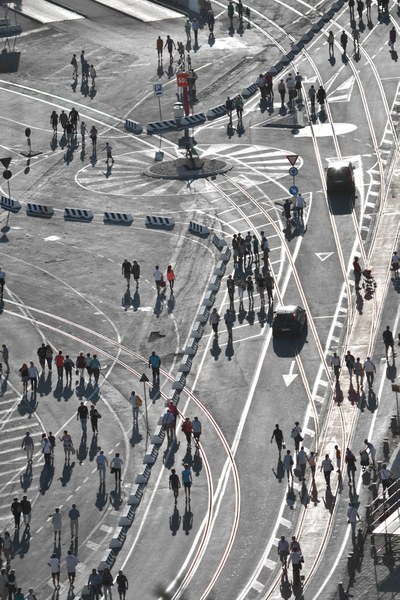All official European Union website addresses are in the europa.eu domain.
See all EU institutions and bodiesToday, the European Commission is publishing its first Zero Pollution Monitoring and Outlook report setting pathways to cleaner air, water and soil. The Commission report, together with the European Environment Agency's monitoring assessment, shows that EU policies have contributed to reducing air pollution as well as pollution from pesticides. However, in other areas such as harmful noise, nutrient pollution or municipal waste generation, problems persist. The results show that overall much stronger action is necessary if the EU is to achieve 2030 zero pollution targets, by adopting new anti-pollution laws and better implementing existing ones.
Progress towards 2030 targets but pollution levels still too high
The progress towards the six ‘zero pollution’ targets is mixed. Pollution is decreasing from pesticides, antimicrobials and marine litter. Not much progress has been made for pollution from noise, nutrients and waste. On the other hand, the overall high rates of compliance with the EU drinking and bathing water pollution standards (>99% and >93% respectively) are encouraging. For 2030, we can achieve most of the targets if additional efforts are made.
However, current pollution levels are still far too high: over 10% of premature deaths in the EU each year are still related to environmental pollution. This is mainly due to air pollution, but also to noise pollution and exposure to chemicals, which is likely to be underestimated. The pollution similarly damages biodiversity. There are significant differences between Member States, with premature deaths levels around 5-6% in the North and 12-14% in the South and East of Europe.
The Commission has by now delivered or advanced on all 33 of the announced actions in the Zero Pollution Action Plan of 2021. In order for them to have an impact, the Commission report calls for the swift agreement and adoption of the legislative proposals to reduce harmful pollution, and the improved implementation of the existing ones at local, national and cross-border level. Notably, it finds that if the EU implements all relevant measures proposed by the Commission, the number of premature deaths due to air pollution would fall by up to 66% in 2030 compared to 2005, with benefits of clean air measures outweighing costs and leading to overall GDP gains. The report also points to the importance of promoting global initiatives and supporting third countries in their efforts towards reducing pollution.
Executive Vice-President for the European Green Deal Frans Timmermans said:
"Once again the evidence presented today shows us that the benefits of acting for clean air, water and soil are far greater than the investment. This is also what citizens want, as more than 80% are worried about the health and environmental problems caused by pollution".
Commissioner for the Environment, Oceans and Fisheries Virginijus Sinkevičius said:
“Today we are presenting compelling evidence about the results of ambitious action to reduce pollution. The reports show that the EU’s zero pollution ambition is realistic and possible, but only if we speed up adoption of legislative proposals linked to pollution, and step up implementation of the existing EU pollution laws. I also hope that today’s reports will help convince our global partners to agree on equally ambitious targets in the context of the upcoming COP15 negotiations on biodiversity”.
Executive Director of the European Environment Agency Hans Bruyninckx added:
The EEA’s first zero pollution monitoring report shows that Europe is making progress in reducing and preventing pollution in key areas, such as air, bathing water and drinking water, and is using less hazardous pesticides. But, to deliver on our 2050 vision, we need progress in reducing excess nutrients in the environment and the health impacts of noise and chemicals, and identifying emerging issues earlier.
See the EEA's zero pollution monitoring assessment web report.
EEA monitoring assessment shows mixed picture
- Good progress in reducing the health impacts of air pollution has been achieved, with a 45% fall in premature deaths since 2005. If this past trend continues, the EU will be on track to meet the target of a 55% reduction.
- The area of land negatively affected by air pollution has fallen by 12% since 2005. If this past trend continues, the EU will not meet the target of a 25% reduction.
- Little progress has been made in reducing nutrient losses since the 2012-2015 baseline. Based on the limited progress to date, the EU is not on track to achieve the 50% reduction target.
- The use and risk of pesticides has fallen by 14% since the baseline period of 2015-2017, while the use of more hazardous pesticides has fallen by 26%. Based on this recent trend, the EU is on track to meet its target of cutting the use and risk of pesticides, and the use of the more hazardous pesticides, by 50%.
- Sales of veterinary antimicrobials have fallen by 18% since 2018. If this past trend continues, the EU will be on track to meet the target of a 50% reduction.
- There was no significant reduction in the share of people impacted by transport noise between 2012 and 2017. With no indications of noise levels having declined significantly since then, the EU is unlikely to meet the target of reducing the share of people chronically disturbed by transport noise by 30%.
- Provisional analysis suggests that the amount of plastic litter at sea has fallen in recent years. While this is encouraging, consistent and comprehensive EU-wide data is needed to assess progress towards the targets of reducing plastic litter at sea by 50% and reducing releases of microplastics into the environment by 30%.
- Total waste generation has slowly increased between 2010 and 2018, with a sharp drop in 2020 related to the pandemic. Residual municipal waste (waste that is not recycled or reused) generation has been stable since 2016. If these waste streams do not decline significantly in coming years, the EU will not meet the targets of significantly reducing total waste generation and of reducing residual municipal waste by 50%.
Background
Today’s report by the European Commission is supported by in-depth analysis from the European Environment Agency for the monitoring part, and includes a contribution by the Joint Research Centre for the outlook part. The web-based Zero pollution monitoring assessment, prepared by the European Environment Agency, provides a cross-cutting assessment on pollution centred around the themes of production and consumption, health and ecosystems.
Pollution is the largest environmental cause of multiple mental and physical diseases, and of premature deaths, especially among children, people with certain medical conditions and the elderly. Pollution is also one of the five main threats to biodiversity.
Under the Zero Pollution Action Plan, the Commission launched nine flagships and 33 dedicated actions to prevent and reduce pollution, most recently, the Zero pollution package for cleaner air and water.
All reports will be discussed at the upcoming Zero Pollution Stakeholder Conference on the 14 December 2022.
The monitoring and outlook assessment serves as a baseline for future reviews of progress the EEA will conduct, the next being scheduled for 2024, to support the European Commission and Member States in delivering the targets. It will also inform future policies designed to support the zero pollution ambition — to reduce pollution to the extent that it no longer presents a risk to human health and the environment by 2050.
For information
- The European Commission's Zero Pollution Monitoring and Outlook Report
- Third Clean Air Outlook Report and underpinning study
- EEA Zero pollution monitoring assessment
- JRC Zero pollution outlook 2022 and news
- RTD report ‘Horizon projects supporting the zero pollution action plan'.
- Zero Pollution Action Plan website
- Zero Pollution package of 26 October 2022 (IP 22 6278)
- Zero Pollution Stakeholder Conference including registration
- Eurobarometer: “Attitudes of Europeans towards Air Quality”










